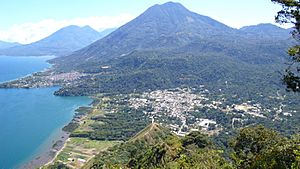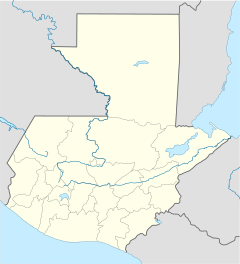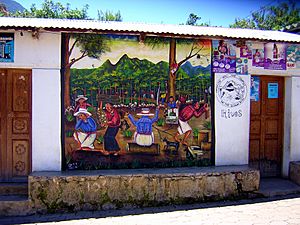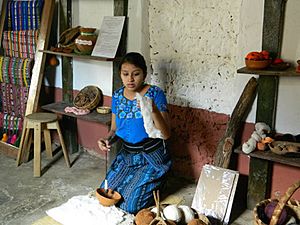San Juan La Laguna facts for kids
Quick facts for kids
San Juan La Laguna
Xe' Kuku' Juyu'
|
|
|---|---|
|
Municipality and town
|
|

San Juan La Laguna
|
|
| Country | |
| Department | |
| Government | |
| • Type | municipal |
| Area | |
| • Total | 3,718 km2 (1,436 sq mi) |
| Lowest elevation | 1,562 m (5,125 ft) |
| Population
(2002)
|
|
| • Total | 10,177 |
| • Density | 27,372/km2 (70,890/sq mi) |
| Time zone | UTC-6 (Central Time) |
| Postal code |
07017
|
| Country calling code | 502 |
| Climate | Aw |
San Juan La Laguna is a town and municipality in Guatemala. It is located on the southwest shore of Lago de Atitlán in the Sololá region. The town includes the main village of San Juan La Laguna and three smaller villages in the nearby mountains. About 95% of the people living here are Tz'utujil. Farming is very important for the town's economy. The number of tourists visiting is also growing. The lowest point in the town is the shore of Lago Atitlán, which is about 1,562 meters (5,125 feet) above sea level.
This town is special because a local rule stops people from outside the area from buying land there. This means visitors can experience the culture of the native Tz'utujil people more closely.
Contents
How People Make a Living in San Juan La Laguna
San Juan La Laguna is like other towns around the lake. For a long time, people here made money from fishing and farming. Before tourists started coming about ten years ago, women had to climb mountains to sell their handmade fabrics to other communities.
Weaving and Textiles
Now, San Juan is home to Trama Textiles. This is a group of women who work together to make fabrics. They use a very old Mayan method called backstrap loom weaving. As of 2020, they sell their products to partners all over the world. This helps them reach many customers and earn more money.
Farming and Fishing
The fishing industry has faced problems recently. The number of fish in the lake has been going down. This happened partly because a fish called the Black Bass was brought into the lake in 1958. This was done to attract more people who like to fish for fun. However, it upset the lake's natural balance. It even caused some local birds and fish to disappear. Most fishermen still earn money by taking tourists out in their traditional boats. But they are worried about the future of fishing. The main crops grown in the area are avocado, coffee, cacao, and corn.
Who Are the Tz'utujil People?
San Juan La Laguna is home to the Tz'utujil, who are one of 21 different Maya groups. The Tz'utujil speak their own language, also called Tz'utujil. They share the coast of Lake Atitlán with another Maya group, the Kaqchikel.
Ancient History of the Tz'utujil
Long ago, the Tz'utujil people's main city was near Santiago Atitlán. It was called Chiya' ("At the Water") or "Tzikinjaay." In 1523, a Spanish conquistador named Pedro de Alvarado conquered this city. He had help from the nearby Kaqchikel people. The ruins of this old capital are on a hill by the lake. It is known as Chuitinamit, which means "the walled-town above."
Languages Spoken in San Juan La Laguna
The main native language in San Juan La Laguna is Tz'utujil. Most people in the main town still speak it as their first language. However, in three smaller villages of the municipality—Palestina, Panyevar, and Pasajquim—many people now speak K'ichee'. These villages were settled by K'ichee' people a long time ago.
Life After the Civil War
Guatemala had a long Civil War from 1960 to 1996. This war was fought between the government and a rebel group. It greatly affected the men in Guatemala, leaving many women to support their families alone. This is why women's weaving groups started to appear across Guatemala. San Juan has one of these groups, Trama Textiles. It provides jobs for about a dozen women at any time.
See also
 In Spanish: San Juan La Laguna para niños
In Spanish: San Juan La Laguna para niños




